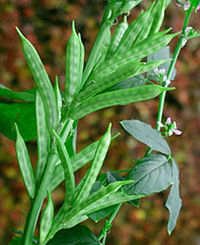
Photo from wikipedia
An environmentally friendly improvement method with using biopolymer stabilization of soil has been currently paid more attention for geotechnical engineering practices. And the existing concerns focused on the performance of… Click to show full abstract
An environmentally friendly improvement method with using biopolymer stabilization of soil has been currently paid more attention for geotechnical engineering practices. And the existing concerns focused on the performance of biopolymers treated clay due to the occurrence of electrical interaction. Therefore, the effect of biopolymer types and water content on the behaviors of biopolymer-clay mixture should be firstly explored in terms of biopolymer applications. In this study, fall cone tests were conducted to evaluate the consistency variations of eight types of biopolymers treated clay, e.g., carrageenan kappa gum (KG), locust bean gum (LBG), xanthan gum (XG), agar gum (AG), guar gum (GG), sodium alginate (SA), gellan gum (GE) and chitosan (CH) at various biopolymer concentrations (e.g., between 0.1% to 5% biopolymer to soil mass ratio). The results indicated that neutral biopolymers (e.g., LBG and GG) significantly caused the increase of liquid limit and undrained shear strength regardless of biopolymer concentration. And the liquid limit and undrained shear strength of negative charged biopolymers (e.g., KG, SA, GE and XG) treated clay decreased firstly following increased, while AG and CH had limit effect on soil consistency. In addition, the trend of plasticity index was similar to liquid limit altering the USCS classification of biopolymer treated clay as silt or clay. Moreover, empirical equations determining undrained shear strength and shear viscosity of biopolymer-treated clay were also established.
Journal Title: Geomechanics and Engineering
Year Published: 2021
Link to full text (if available)
Share on Social Media: Sign Up to like & get
recommendations!